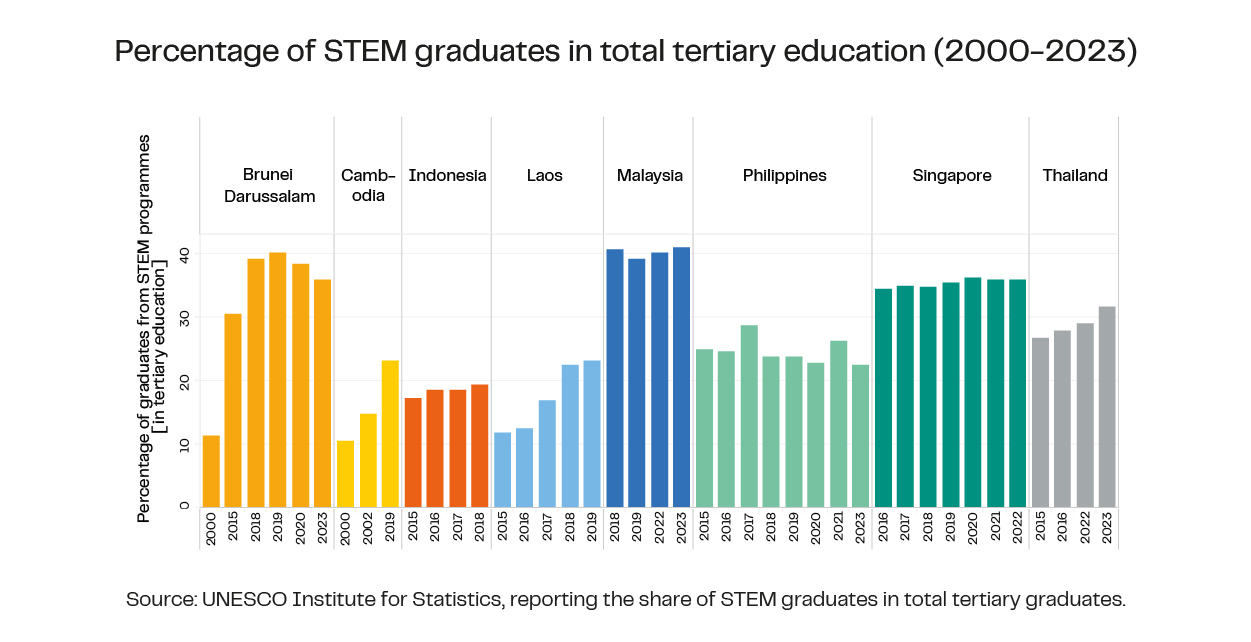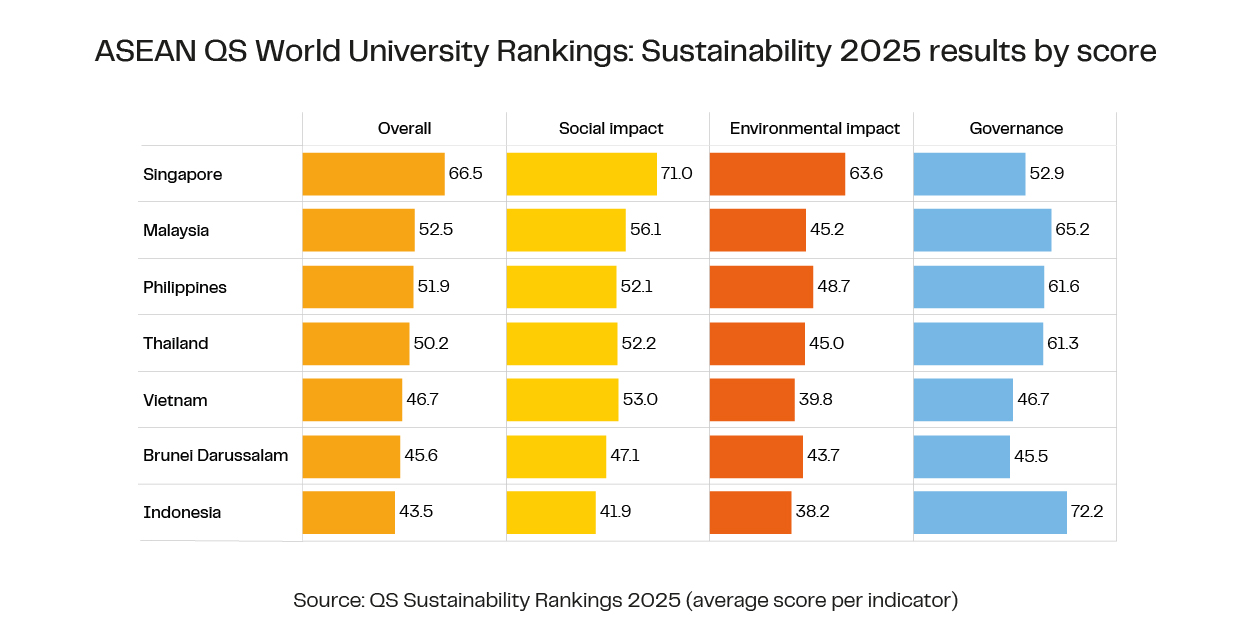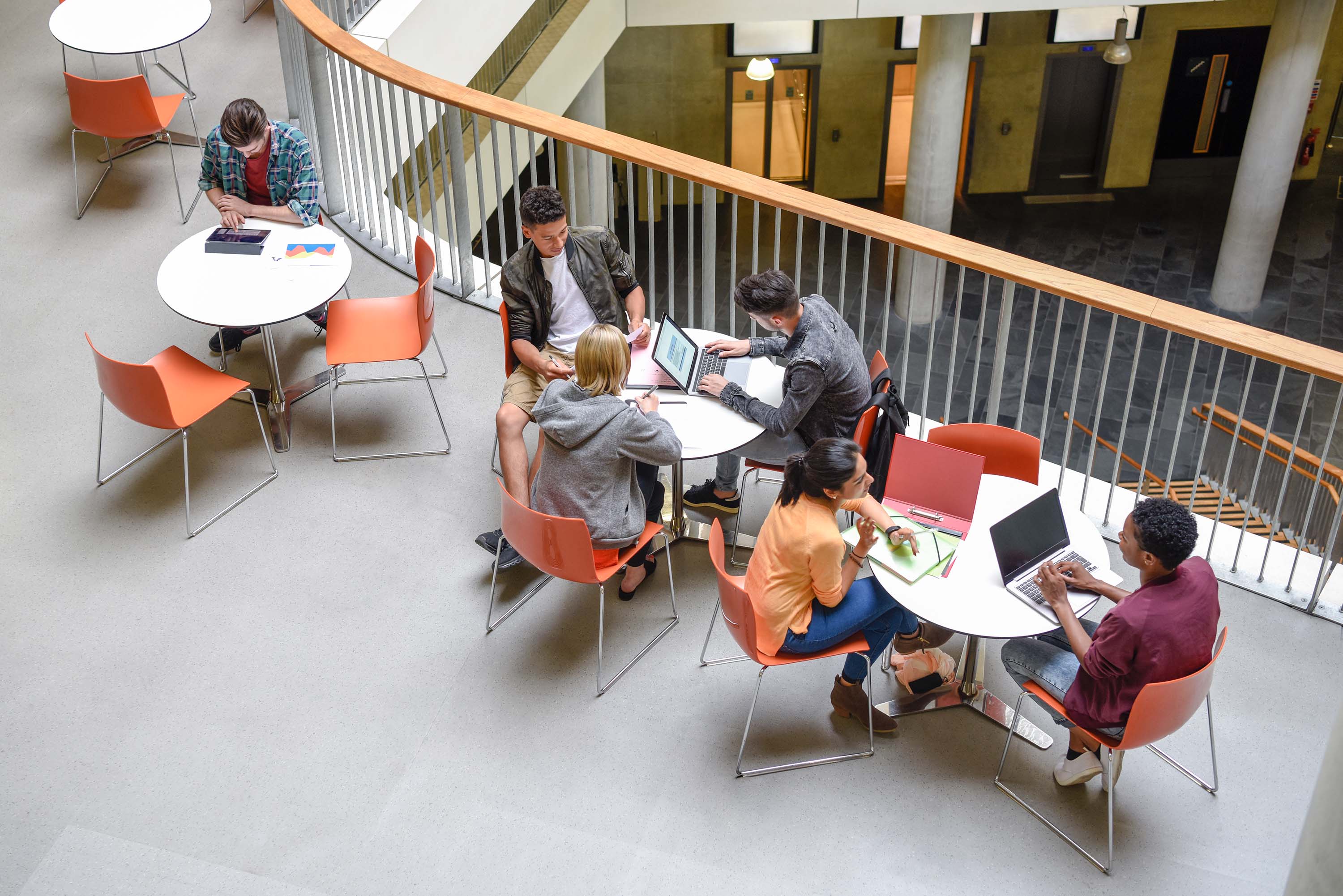In this report, QS explores how higher education across Southeast Asia is driving economic growth, innovation, and sustainability. As our Executive Director Jeroen Prinsen writes, “The future of ASEAN will be written in its classrooms, laboratories, and partnerships.” Universities are more than centres of learning - they are the engines powering a digital and green transformation.
Below is a short excerpt from our report titled: How universities are shaping ASEAN’s tomorrow. Download the full report to uncover the data, country insights, and opportunities shaping ASEAN’s next decade.
Executive summary
ASEAN universities are acquiring global visibility
Universities in many ASEAN countries are climbing in global rankings, with Malaysia and Indonesia making notable strides into the QS World University Rankings top 250 between 2016 and 2026. This visibility is not only symbolic, but influences partnerships, investment, and talent flows. Singapore remains the established leader, while other countries are beginning to see meaningful progress, highlighting ASEAN’s emergence as a credible higher education hub.
Skills and employability alignment could generate US$900 billion in additional value
Employers across ASEAN highlight persistent gaps in critical thinking, problem-solving, and green competencies. These shortfalls matter - aligning education with labour market needs could generate US$900 billion in additional economic value by 2035. Digital transformation alone is projected to create 65 million new jobs by 2030, yet many ASEAN graduates still lack the advanced digital and green skills required. Expanding access to STEM and AI-related programmes, while embedding adaptability and sustainability into curricula, will be central to unlocking this value.
ASEAN countries have distinctive strengths – and together, have the potential for rapid momentum
The QS World University Rankings: Sustainability and the QS World Future Skills Index reveal ASEAN’s distinctive strengths and challenges. Singapore leads regionally with strong sustainability and Skills Fit scores, while Malaysia shows high Academic Readiness but struggles with Economic Transformation. Vietnam and Indonesia demonstrate rapid upward momentum, particularly in skills demand and research output. These comparative insights underscore ASEAN’s diversity: a region with standout performers, fast movers, and systems still building the foundations for long-term competitiveness.
Key takeaways for ASEAN members
Brunei Darussalam
- Brunei benefits from strong governance and a solid foundation in higher education.
- The country is working to diversify beyond oil by strengthening innovation and skills.
Cambodia
- Cambodia is growing international partnerships and expanding access to higher education opportunities.
- The system is gradually developing stronger research capacity and national quality frameworks.
Indonesia
- Indonesia’s higher education sector is expanding rapidly, with universities gaining greater international visibility.
- The country is working to align graduate skills with the fast-growing digital economy.
Laos
- Laos shows high collaboration rates, helping its universities connect to global research networks.
- Efforts continue to build domestic university capacity and expand sustainability-focused programmes.
Malaysia
- Malaysia is expanding its presence in global rankings and attracting more international students.
- The system is focusing on creating higher-quality jobs to match its strong graduate output.
Myanmar
- Myanmar has a talented student base and strong regional ties through ASEAN networks.
- The higher education system is seeking stability and rebuilding international connections for research.
Philippines
- The Philippines has strong demand for graduates in ICT and digital sectors worldwide.
- Universities are improving curricula to better match rapid employer demand and evolving industries.
Singapore
- Singapore’s universities are global leaders in research, innovation, and sustainability.
- The country continues to work on widening access and easing cost pressures for students.
Thailand
- Thailand is steadily raising research investment and strengthening its science and technology base.
- Efforts are underway to address inequality and environmental pressures while improving education quality.
Vietnam
- Vietnam is seeing some of the fastest growth in patents and research productivity in ASEAN.
- The country is working to reduce coal dependency while strengthening higher education readiness.
ASEAN universities gaining global visibility
Across ASEAN, more universities are breaking into global rankings, but the progress is far from uniform. Malaysia has added 12 institutions to the QS World University Rankings since 2022, reaching 34 by the 2026 edition. Indonesia has shown an even steeper climb, from 16 to 38 over the same period. Other countries, such as the Philippines, Thailand, and Vietnam, are gaining ground more slowly, while Singapore has largely held steady. The overall picture is clear: ASEAN’s higher education sector is becoming more visible, but momentum is concentrated in a handful of countries.
.jpg)
This growing visibility matters. The QS World University Rankings are not just about prestige, they influence international partnerships, attract talent, and shape how economies are perceived abroad. Indonesia’s surge reflects the impact of recent reforms and investments, while Malaysia’s consistency points to a well, developed higher education system with strong international engagement. In contrast, slower gains in Vietnam and the Philippines highlight the need for deeper structural support. Rankings are therefore a barometer: they show where governments and universities are aligning long-term investment in research, teaching, and global collaboration.
.jpg)
Climbing into the world top 250
What is particularly striking is how Malaysia and Indonesia are not only adding more universities to the overall rankings but also moving into the upper tiers. Between 2016 and 2026, Malaysia has expanded its presence in the QS World University Rankings top 250 from a single institution to five, while Indonesia has gone from none to two. This shift signals more than just incremental progress. It signals that universities in these countries are starting to compete at a level once dominated by established education powers. For ASEAN, it suggests that the region’s higher education is no longer merely expanding in numbers but is beginning to consolidate quality and global credibility. The rise into the top 250 strengthens the region’s claim as an emerging hub of talent and research excellence, reinforcing the momentum already visible in the broader rankings growth.
Regional leaders and emerging peers
Singapore’s National University of Singapore (NUS) and Nanyang Technological University (NTU) continue to dominate, consistently ranking among the very top globally. Malaysia’s University of Malaya has also entered the world’s upper tier, consolidating its position as the region’s leading university beyond Singapore. These institutions stand out thanks to international research collaborations and strong employer recognition.
Elsewhere in ASEAN, the leading universities of Indonesia, Thailand, the Philippines, and Vietnam are climbing but remain much lower in global tables. Their challenge is scaling up research capacity, deepening international partnerships, and building stronger reputations abroad. The gap highlights how concentrated leadership is today, but also the potential for others to rise
Skills, employability, and the future of work
Skills
What employers tell us about graduate skills
The QS Employer Survey offers a window into how companies view graduate readiness. Across ASEAN, more than 12,000 employers have contributed their perspectives, forming part of a global dataset of 75,000 responses. Their feedback highlights both progress and pressure points. Teamwork and ethics are recognised as strengths, but employers consistently call out gaps in critical thinking, problem-solving, and environmental awareness. Because the survey is conducted every year, it allows us to follow how these expectations are changing as digitalisation, automation, and climate goals reshape the workplace.
How ASEAN universities are performing in key disciplines
Alongside employer insights, the QS World University Rankings by Subject track how institutions build reputation and research strength across 55 disciplines. In 2025, 5,203 universities were analysed across 148 locations; 1,747 made the final published results.
The picture in ASEAN is mixed. In computer science and information systems, for instance, 45 of 850 ranked universities worldwide are from the region, just over 5% of the global total. Yet within this limited share, a few standouts, such as the National University of Singapore and Nanyang Technological University, are now ranked among the world’s top 20. Some institutions in Malaysia and Thailand are also improving performance. These results show where institutions are making progress, but also where the region’s capacity still falls short of its ambition to be a hub for developing the digital economy and climate skills that will be necessary in a reshaped workplace.
Looking ahead to the future of work
When taken together, employer data and subject rankings give a clear picture of the challenges and opportunities ahead. In engineering, for example, employers in ASEAN rate graduate performance in critical thinking at 5.4 out of 10 compared with a global average of 6.7. Such gaps sit alongside strong demand projections: the Asian Development Bank estimates digital transformation alone could generate 65 million new jobs in Southeast Asia by 2030, while QS analysis suggests that aligning education with labour-market needs could deliver nearly US$900 billion in additional economic value by 2035. Closing these gaps is about more than employability, it is central to the region’s ability to compete and thrive in the decades ahead.
Strength in collaboration, gaps in innovation
Employers across ASEAN value teamwork most highly (9.3 out of 10), and graduates deliver relatively well here, with a satisfaction score of 8.0. Yet when it comes to communication (9.2 vs 7.1), problem-solving (9.2 vs 6.8), and critical thinking (9.1 vs 6.8), the gaps are much wider. This highlights a recurring concern: while universities are strong at imparting subject knowledge, they remain less effective at equipping graduates to adapt that knowledge in practice. The result is a skills shortfall in exactly the areas industries need most as digitalisation and automation accelerate.

Where gaps are widest
The most striking weaknesses appear in emotional intelligence (8.9 importance vs 6.5 satisfaction) and resilience (8.8 vs 6.8), qualities that are critical for leadership and adaptability but often overlooked in traditional curricula. Entrepreneurship is rated lowest overall (6.3 vs 5.4), reflecting the fact that outside finance and fast-growing sectors like fintech and e-commerce, employers place less emphasis on entrepreneurial capability. In finance, as we saw earlier, entrepreneurship was more valued, but in many other industries it remains peripheral. By contrast, ethics and social responsibility (8.8 vs 7.4) records one of the smallest gaps, showing that universities are responding to demand for more socially conscious graduates. Overall, ASEAN institutions have made progress in teamwork and values-based education, but the biggest challenge remains in strengthening cognitive and adaptive skills that employers consistently rank near the top.
Employability
Turning low unemployment into future readiness
ASEAN’s advantage lies in its relatively low youth unemployment compared to the global average of 13% (ILO, 2023). Yet the real opportunity is in how the region can harness this stability to prepare for the future of work. The Asian Development Bank (ADB, 2024) estimates that digital transformation alone could generate 65 million new jobs in Southeast Asia by 2030, while the World Economic Forum warns of significant shortfalls in AI and green-skilled professionals. By aligning higher education more closely with these emerging fields, ASEAN can ensure its young workforce not only finds employment but also leads in shaping the digital, green, and AI-driven economies of tomorrow. With unemployment pressures relatively contained, the region is uniquely placed to invest in quality, not just quantity, of opportunities for its graduates.
Youth unemployment and graduate opportunities
.jpg)
Figure 13 compares tertiary gross enrolment ratios with youth unemployment rates, using data averaged across 2022–2024 to fill gaps in country reporting. It highlights how expanding higher education does not always translate into higher youth unemployment. Thailand (4.4%) and Vietnam (5.1%) record some of the lowest unemployment levels globally, showing that young people are entering the workforce successfully even as university participation rises. Malaysia (11%) and the Philippines (8.8%) sit near the global average, reflecting competitive but functional labour markets. At the extremes, Brunei (20%) reveals a tension between graduate expectations and job creation, while Cambodia (1.1%) shows how limited enrolment can reduce short-term labour pressures.
High STEM graduate rates and their economic impacts

Figure 14 shows that both Malaysia and Singapore have among the highest shares of STEM graduates in the ASEAN region often approaching or exceeding 40% of all tertiary graduates.
In practical terms, this aligns well with both countries’ economic strategies: Malaysia’s leadership in manufacturing high-tech goods, especially semiconductors and electronics, relies on a robust pipeline of STEM-trained graduates, while Singapore’s intense focus on innovation and biotech similarly depends on this talent pool. The high STEM enrolment reflects deliberate policy choices and long-term planning. Singapore’s education system, for instance, promotes STEM from secondary through applied learning programmes and direct industry links, nurturing interest early on and ensuring relevance to future jobs. These strategies underpin both economies’ readiness to adapt to labour-market shifts and support their evolution as knowledge-driven hubs. However, this STEM focus also invites reflection: as much as STEM capacity fuels innovation, it must be complemented by growth in interdisciplinary and soft skills, like critical thinking, design, and environmental literacy, to ensure graduates are adaptable and the economy remains resilient.
ASEAN’s place in QS World University Rankings: Sustainability
Building stronger sustainability practices
Singapore stands out with the highest overall sustainability score in ASEAN, reflecting consistently strong performance across social impact, environmental impact, and governance. This top performance is driven by Singapore’s robust national sustainability policies (for instance, the Green Plan 2030 targeting carbon emissions and green urban development) and its effective governance frameworks. These real-world factors translate into the country’s universities excelling in environmental research, social equity initiatives, and transparent institutional governance.
Malaysia follows as a strong performer: national strategies such as mandatory sustainability reporting and green investment incentives have bolstered Malaysian institutions’ social and environmental scores. The government’s promotion of renewable energy and sustainable development is reflected in universities’ outputs, although challenges like deforestation from the palm oil industry and inconsistent enforcement still temper Malaysia’s environmental metrics.
Thailand’s average scores are moderate but on an upward trend; policies like sustainable tourism initiatives and enhanced corporate governance regulations have helped lift its performance. However, issues such as pollution and social inequality persist, meaning Thailand’s gains in environmental and social impact remain limited by these longstanding challenges.

Different journeys across the region
The remaining ASEAN countries show more mixed sustainability outcomes. The Philippines’ scores reflect its significant climate and social vulnerabilities: as one of the world’s most disaster-prone nations with widespread poverty, it struggles in environmental and social impact categories despite some renewable energy initiatives. Persistent governance issues like corruption remain a hurdle for the Philippines’ overall sustainability efforts. Indonesia likewise faces sustainability hurdles: its environmental impact is constrained by ongoing deforestation and land-use emissions even though the government has pledged emission cuts and imposed a forest-clearing moratorium (with limited enforcement). Social conditions in Indonesia have seen gradual improvements in labour standards, but corruption and related governance challenges persist, even as universities and authorities adopt ESG practices to strengthen transparency and governance.
Vietnam’s sustainability profile reflects a country in transition: the government has set ambitious renewable energy targets and labour reforms to improve social outcomes, yet heavy reliance on coal and still-developing governance frameworks keep its environmental and governance scores relatively low. In contrast, Brunei Darussalam’s high-income welfare state provides a strong social foundation and well-regulated institutions, but its oil-dependent economy results in a relatively low environmental score due to slow adoption of renewable energy initiatives.
Green skills are a shared priority for ASEAN industries and universities
Across ASEAN, the QS Global Employer Survey shows that employers consistently place a high value on environmental awareness skills, with sectors like agriculture (9/10) and renewable energy (9.2/10) reflecting the urgency of climate pressures. Agriculture is especially vulnerable to climate change, and the push towards organic and sustainable farming is creating demand for new skills that can also lift rural incomes.

Logistics and transportation stand out with one of the smallest gaps (8.5 importance vs 7.0 satisfaction), likely reflecting global supply chain pressures and national investment in vocational green training, such as Thailand’s TVET programmes in tourism and logistics. Governments themselves are embedding green mandates into public planning, which explains why the public sector shows a smaller gap than most industries.
Other industries reveal sharper misalignments. Pharma and biotech (8.2 importance vs 4.1 satisfaction) and telecoms (8.7 vs 4.9) are clear examples where employers want graduates to apply green responsibility in practice, but higher education programmes are not yet equipping students with those skills. Malaysia’s new Green Jobs Act is one policy example linking business incentives to education and workforce preparation16. Similarly, ASEAN’s regional skills framework highlights the need to embed green skills into TVET and higher education, but implementation is still uneven17. These findings suggest that unless universities reform curricula in fast-growing industries like biotech and telecoms, ASEAN risks losing part of the projected US$160 billion economic18 benefit that could come from sustainability-focused education over the next decade.
Recommendations
1. Update curricula to enable current and future skills needs
Universities across ASEAN need to bring digital, AI, and green skills directly into their teaching. Closing today’s gaps could add almost US$900 billion to the region’s economies by 2035.
2. Work hand in hand with industry
Employers keep saying they need more problem-solvers and critical thinkers. Universities should design programmes with industry, expand internships, and back applied research that answers real business needs. This not only makes graduates more employable but also helps keep talent in high-value sectors at home.
3. Build regional research capacity
Stronger research ecosystems will lift the whole region. Expanding investment, creating joint research centres, and encouraging cross-country projects will allow more universities to contribute to innovation. A wider base of research capacity will make ASEAN more competitive globally.
4. Ensure sustainability is front and centre of research, teaching and operations
Sustainability should run through everything universities do, teaching, research, and campus operations. From renewable energy adoption to embedding environmental responsibility in curricula, institutions that put sustainability at their core will be better placed to attract talent, investment, and partnerships.









.jpeg)











